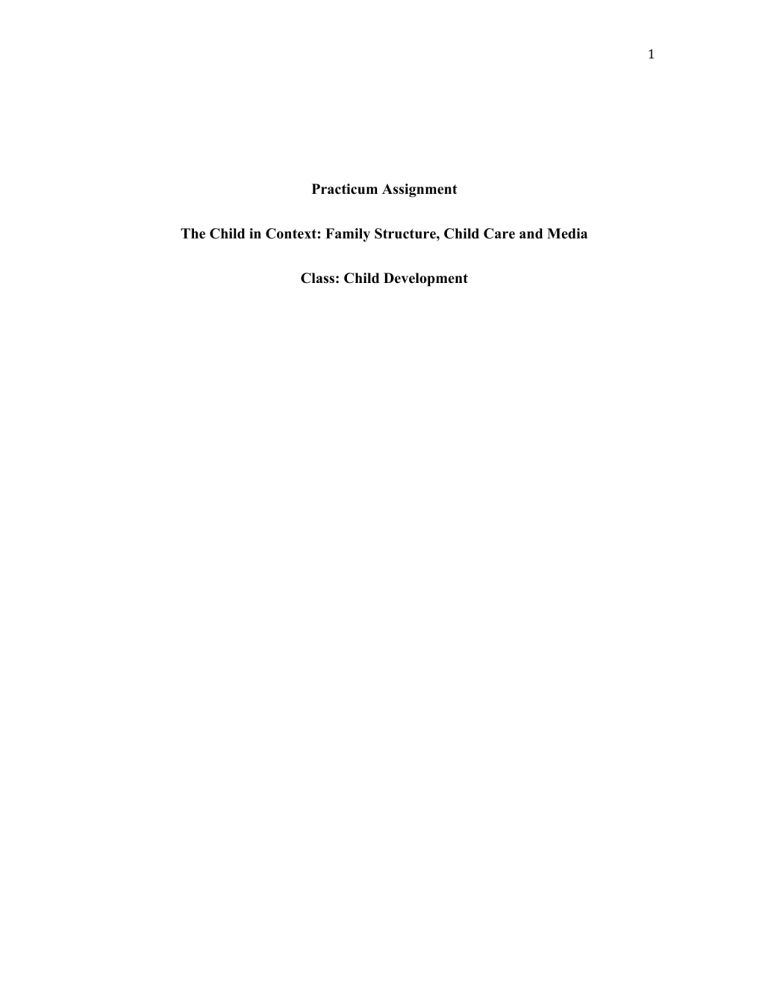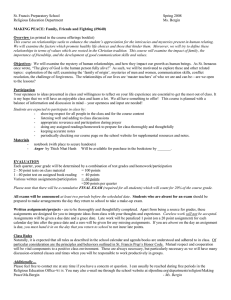
1 Practicum Assignment The Child in Context: Family Structure, Child Care and Media Class: Child Development 2 Classroom Implications of Family Structure and Parent Involvement Parent involvement leads to student success for several reasons. Most important among them is the concept of academic socialization in which parents who discuss school at home leads to student’s who are academically ahead by on year over parents who did not, irrespective of socio-economic status (SES) (Ream & Palardy, 2008). This positive effect on academic success occurs as a result of increased skills and motivation. Involvement parents convey the value of education and clarify academic success as a priority in their family that the children absorb. This also leads to a cultural match-up between home and school that further boosts the chance of success for children who experience academic socialization in their home (Bergin & Bergin, 2018). Family involvement is important to a student’s education because research shows that it leads to significant success over students who have uninvolved families (Ream & Palardy, 2008). Students who have families who are involved in education, either at school or at home, perform better academically (Cotton & Wikilund, 1989). Currently, 70% of parents in the U.S. participate in parent-teacher conferences and 40% of parents volunteer at the school (Bergin & Bergin, 2018). Students whose parents volunteer at school have been found to be more socially successful, well behaved, and less depressed than their peers with less involved parents (Bergin & Bergin, 2018). Home involvement may include positive practices such as reading with students each evening and watching over homework completion, if done appropriately (Bergin & Bergin, 2018). The positive effect of parent involvement in education can be erased by negative interactions around school issues. For example, parents who are overinvolved in homework and who convey confusion or tension can increase anxiety in children and 3 decrease academic success (Bergin & Bergin, 2018). Eventually, involved parents who are overbearing can lead children to lower academic success. This effect is magnified for lower performing children (Bergin & Bergin, 2018). I will incorporate parent involvement in my classroom in several ways. First, I will strive to communicate at least one positive message per student to parents by email as a way to build trust with families. So often, with my own children, the first communication I ever received from middle and high school teachers was a negative one noting missing work or a behavior issue. I would like parents to internalize that not all communications from teachers will negative and no matter whom their child is, they are beloved and recognized as worthwhile. Regardless of performance, all students have gifts and those should be recognized and pointed out by teachers. Along these lines, I plan to personally invite parents to be involved in their child’s learning while establishing a workable system of communication between us such as email (Cotton & Wikilund, 1989; Bergin & Bergin, 2018). The barrier to these practices is time constraints. Communication with parents is valuable, but can be very time-consuming. It will be important to reach out on a schedule, but also keep boundaries around responding to excessive requests from parents. Classroom Implications of Maternal Employment and Child Care Child care availability plays a role in family employment opportunities. High quality child care is in shortage in the U.S. and research suggests that only 10-17% of child care settings qualify as high quality (Vandell, Belsky, Burchinal, & Vandergraft, 2010). The lack of affordable child care in the U.S. affects the ability of mothers to 4 secure employment, but does not affect the ability of fathers to find employment (Schochet, 2019). Maternal employment has an impact on child development, but in a complicated way. Maternal employment affects children’s development both positively and negatively, depending on the situation (Bergin & Bergin, 2018). SES largely determines this effect. If a low-income sensitive mother can secure part-time employment (30 hours or less) during standard hours, it will have a positive effect on her children. In contrast, if the mother has non-standard work hours, non-sensitive mother, full-time employment, or is working during infancy, the positive effect on child development of the maternal employment is dampened (Bergin & Bergin, 2018). Additional factors that improve the outcome for children include whether the mother’s employment helps the family leave welfare, whether the mother enjoys her work and believes her work is important for the family’s well being and whether the mother spends time with her children outside of work hours (Bergin & Bergin, 2018). Therefore, especially for low income families, maternal employment is a net positive for families under the right circumstances. Classroom Implications of Media Use Technology is ubiquitous among high school students in the modern age. As such, it affects the classroom. Modern adolescents spend more than 7 hours per day on devices, not including school work, and tween spend more than 4 hours per day (Jacobo, 2019). 93% of U.S. adolescents have access to the internet and have a social media profile, an email account and text more than 100 times per day (Bergin & Bergin, 2018). The dramatic difference in media comfort and use among my own children (ages 18, 15 and 11) is a testament to the rapid pace of comfort that children are developing with 5 technology. My 18 year old has never become a digital native in the way my 11 year old has. The dramatic increase in the use of technology by adolescents has implications for the classroom. There are four main concerns that arise from the use of social media in the classroom. They are distraction, academic cheating, discerning fact from fiction and cyber bullying (Kapko, 2014). Research suggests that heavy users of non-educational media tend to have lower academic success and have worse behavior in the classroom (Bergin & Bergin, 2018). Our local middle school recently banned all devices while in school to the chagrin of most students. The parent-driven movement cited distraction and cyber bullying as the primary reason to push for the change in status. My own student graduated from the school before the ban took place. In my opinion, it is imperative that teachers manage social media from their classroom (Kapko, 2014). Last year, when she was an 9th grader, in response to her teacher’s twitter handle posted in the classroom, my daughter innocently searched for her teacher’s online presence and followed her across three platforms. Although the twitter handle was posted and students were encouraged to follow the teacher, my daughter also found and followed the teacher on other public accounts. Her teacher called her out of the classroom and berated her for doing so and my daughter, who is a top student, apologized and out of respect, unfollowed the teacher on all platforms. Unbeknownst to my daughter, the teacher had previously been stalked by a previous student online and my daughter’s innocent searching triggered the teacher to have an angry reaction to my daughter. The teacher apologized to my daughter when she recognized the inappropriate response she had to innocent searching that pre-teen children engage in daily. The teacher reflected in 6 a conversation with me that the rules she expected students to follow with respect to social media were never taught explicitly to them by her or by any other teacher. More so, her expectations were not in alignment the etiquette rules these students followed themselves. She was ready to rethink her approach to managing social media as a teacher. This story illustrates the disconnect that can occur between teachers and students in the fast-paced world of social media. Some teachers embrace devices in their classroom and social media use as an opportunity to teach students about their responsibilities surrounding social media in school and in the workplace (Kapko, 2014). I hope my children will have teachers who approach social media this way in the future as we all learn to live with a phenomenon that isn’t going anywhere. Despite complications, a dramatic increase in the use of technology and social media is not all bad news. Media can be used to improve teaching and learning. I plan to use media in my high school classroom cautiously. In Earth science, there are several laboratory programs I plan to use to manage data sets so that students can work effectively in groups for learning. These are owned and managed by the team I in which I will work in the fall of 2020. Similarly, I plan to use Quizdom or similar apps to conduct formative assessments during units. I am also considering using classroom blackboard discussion groups or closed Facebook groups for group discussions and notes so that students can talk to each other about classroom issues and projects. As a teacher, I plan to monitor these chats and teach students appropriate etiquette from my point of view as well as them what rules they have developed to manage their social media. For example, I am fascinated by my children’s rule that texts must be answered immediately or it is rude. This is a rule not followed by my generation. With the likelihood that part of the 7 school year will be conducted entirely online, it is past time for all teachers, including myself, to improve their understanding of technology and use it for good in as many places as possible to maintain connection with students. 8 References Bergin, D. A., & Bergin, C. A. (2018). Ch. 14: The Child in Context: Family Structure, Child Care and Media. In Child and adolescent development in your classroom (pp. 573-620). Australia: Cegage Learning. Cotton, K., & Wikilund, K. R. (1989, May). Parent Involvement in Education. Retrieved July 5, 2020, from https://educationnorthwest.org/sites/default/files/parentinvolvement-in-education.pdf Jacobo, J. (2019, October 29). Teens spend more than 7 hours on screens for entertainment a day: The amount of screen time does not include school work. Retrieved July 05, 2020, from https://abcnews.go.com/US/teens-spend-hoursscreens-entertainment-day-report/story?id=66607555 Kapko, M. (2014, September 09). Is Social Media Reviving or Killing Our Classrooms? Retrieved July 05, 2020, from https://www.cio.com/article/2604686/is-socialmedia-reviving-or-killing-our-classrooms.html Ream, P. K., & Palardy, G. J. (2008). Reexamining social class differences in the availability and the educational utility of parental social capital. American Educational Research Journal, 45, 238-273 Schochet, L. (2019). The Child Care Crisis Is Keeping Women Out of the Workforce. Retrieved July 05, 2020, from https://www.americanprogress.org/issues/earlychildhood/reports/2019/03/28/467488/child-care-crisis-keeping-women-workforce/ Vandell, D., Belsky, J., Burchinal, J., & Vandergraft, N. (2010). Do effects of early child care extend to age 15 years? Results from the NJCHD Study of Early Child Care and Youth Development. Child Development, 81, 737-756.



